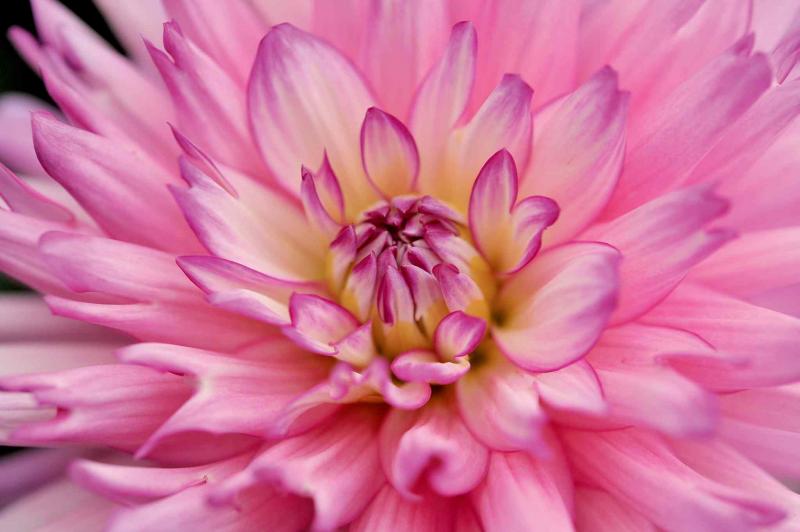This time every year my appetite begins to grow for the prospect of bold, audacious colour in the garden.
As agreeable as pastel pinks, whites and silvers can be, serving to draw the eye along, illuminating a shady area or acting as a harmonizer, what appeals now is the vision of something much warmer.
Dahlias shine bright in containers or flower beds. Drama queens, their exuberant blooms serve as exclamation points in the garden with enough variety of colours to accentuate the hues of any new or existing planting scheme.
Native from Mexico to Colombia, dahlias are said to have grown in the elaborate gardens of Montezuma, the Aztec king. The first drawings made of dahlias appeared in 1651. Grown in the botanical garden at Mexico City, then in the Royal Gardens of Madrid, the plant was named in 1789 for Andreas Dahl, a Swedish botanist.
Easy to grow and hybridize, today there are more than 14,000 cultivars and about 50,000 named varieties. As dahlias are only hardy to zones eight to 10, we treat them as annuals, potting up bulbs (more accurately, tubers) in the spring time, then waiting until it is warm enough to put them outside once all risk of frost has passed.
Not interested in starting dahlia tubers this spring? Or in lifting them next fall for storing over the winter? Garden-ready dahlias are an easy and beautiful alternative.
Don Fryfogel owns Fryfogel Flowers in the RM of Springfield. Not easy to find if you are directionally challenged, but worth the trip, Fryfogel is growing a new series of dahlias vegetatively from cuttings. Known as Dahlia XXL series from dummen group, this new introduction is a game changer for growers who have traditionally started dahlias from tubers. The XXL series has been a strong performer in plant trials throughout North America.
"Many customers," said Fryfogel. "Don't have a place to properly store tubers for the winter. The XXL series is ready to go and gardeners can see the plant in bloom before they buy."
Fryfogel will have four varieties in the XXL series -- Alamos, Durango, Taxco and his favourite, Hildago. With showy, prolific blooms, this compact series has sturdy stems and maintains uniform growth, making it a good choice for patio pots or the front of the border. Colours range respectively from vibrant red to sunflower yellow, dusky-wine red and peachy apricot.
The series also includes a variety called Veracruz which Sue McLeod of Glenlea Greenhouses, plans to carry. Veracruz features lavender and white bicolour flowers in a pom-pom shape. With fully double blooms, the XXL series grow to about 50 cm in height an 45 cm in width.
Dahlia Dreamy is another vegetatively propagated series. McLeod will make it available in larger individual pots and will carry Passion which has intense scarlet blooms, Fantasy which is rose-coral with a hint of gold, and Eyes in a soft orange.
The Dreamy series grows to about 40 cm and is suitable for the border or in patio pots.
McLeod will also carry the Figaro series, a dwarf double dahlia grown from seed. Mounded and upright, mature height reaches 36 to 46 cm.
What if you desire the diverse shapes and drama of tall dinner-plate dahlias grown from tubers? Fryfogel starts these in his greenhouse as well, and this year will offer Ferncliff Illusion, a towering white, extra-large dahlia with lavender tips and Kelvin Floodlight dahlia in a buttery yellow. Both will grow to an approximate height of 130 cm and produce expansive blooms between 23 to 28 cm.
Gardeners who have hesitated to store tubers for the winter, may want to try their hand at lifting these in the fall, says Fryfogel, for an even more impressive show the following year.
How difficult can it be? Not at all if you are Charles Begley, a St. Vital gardener. Begley has grown dinner-plate dahlias for the past 20 years, beginning from the time when he lived in England. Begley's twin brother, who still lives in England, also grows dahlias.
Begley has three methods of growing dahlias. Some he digs up in the fall. After removing the soil from the tubers, he places them into brown paper bags, covers them with peat moss, and stores them in a cool area of his basement away from any heat or light.
Others he stores in the pots in which they were planted the previous summer and transports them in late fall, pots and all, to the same dark, cool area of his basement. Begley finds this method the easiest and was inspired to try it after visiting a garden on a Nature Manitoba garden tour some years ago.
In spring, all of the stored tubers are moved to his three-season sunroom and potted into small containers filled with a well-draining soil mix. Begley waits until the tubers begin sprouting before watering them so as to avoid the risk of rot.
Each year Begley also purchases half a dozen packages of new varieties which he starts in pots. This year his collection will include the additions of Seattle, Misty Day, Tahiti Sunrise, Veritable Cactus, and Smokey.
Dahlias are susceptible to cold and should not be planted outdoors, says Begley, until outdoor temperatures are consistently warm. Patience is always a virtue, and in the case of dinner-plate dahlias, the giants of the ornamental dahlias, the most bountiful radiant displays appear in August right through until the first frost.
Methods of overwintering vary. John Rempel, a Charleswood-area gardener, perhaps better known for his lilies, also grows dahlias from tubers. After digging them up in the fall, he washes off the dirt, allows them to dry so they are not wet, then stores them in black plastic garbage bags in a cool room at a temperature of no more than 50 C.
Starting them early, ensures dahlias reach their maximum potential. In the springtime, usually by early April, Rempel sorts through the tubers, cutting off the best ones and ensuring each has a fine, healthy eye (the growth point from which next year's stems will come), then pots them up into 15 to 20 cm containers.
Tubers should be laid horizontally in the pot with the bud or sprout facing up. Rempel waits until the second week in June before moving them outdoors. When planting them in the garden I have sprinkled bone meal at the bottom of the planting hole and added some bulb dust to ward off pests. Cover the tubers with about 10 to 15 cm of soil.
Larger varieties of dahlias should be spaced 45 to 60 cm apart. Dahlias have shallow root systems, however, the clumps can be sizable, up to 30 cm across. Rempel cautions against growing dahlias in pots that are too small. Providing 30 cm of space per tuber should be adequate.
Bamboo or rebar poles work well for staking and are needed for dahlias that grow to 90 cm or taller. Insert the stake at the time of planting, taking care to not injure the tuber. As the plant grows, tie the stem at intervals to the stake.
While a full sun location is recommended, dahlias can also be grown in locations that receive part sun although the result may be fewer blooms. Mulching helps to conserve soil moisture.
Want the biggest possible blooms and the sturdiest stems?
Rempel removes three to four sets of bottom branches, then pinches off side buds. More difficult, at least from my perspective, is to pinch out the side blooms from the top cluster. The result, however, says Rempel, is a really good sized dahlia bloom.
Jensen's Nursery will have a large display of dahlia tubers at this year's Gardening Saturday Tradeshow, March 28th, at the Victoria Inn. Some of the dinner-plate varieties include Babylon Red, Labyrinth and Purple Taiheijo.
Jensen's will also feature Twynings Smartie, a delightful variety that features petals in two colours, some reddish-purple others in pure white. Centres are a showy golden-orange.
Dahlias make beautiful cut flowers. The best time to cut stems is in the early morning, preferably when the temperature is cooler than 18 C. Place stems into very hot water for no more than 15 to 20 seconds, then allow them to cool in a container of cold water for about one hour. This will set your blooms and flowers should last for up to five days.




